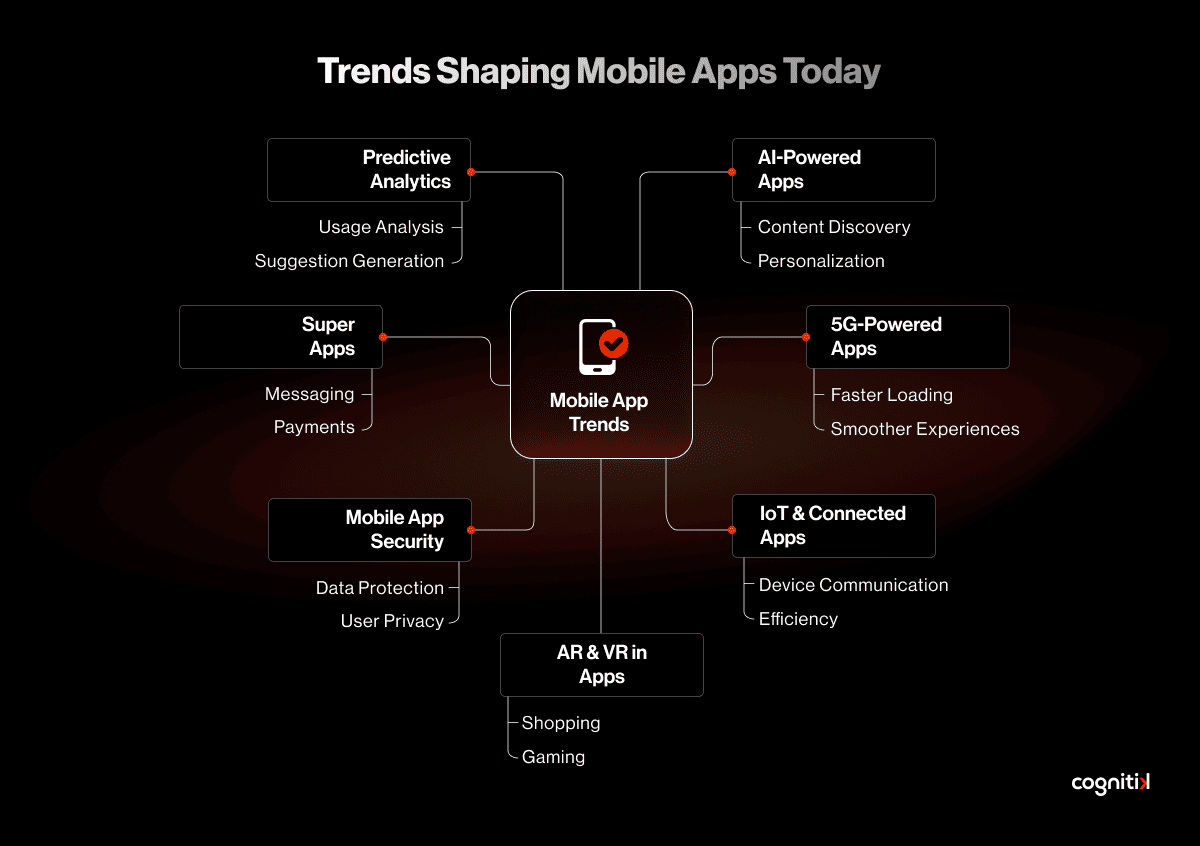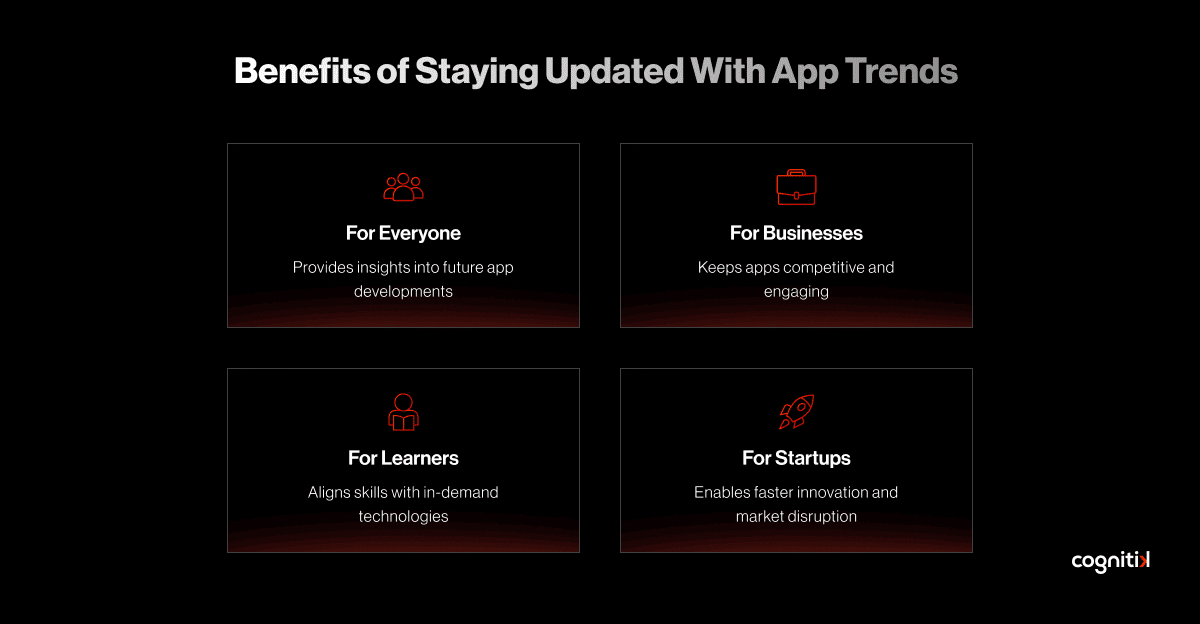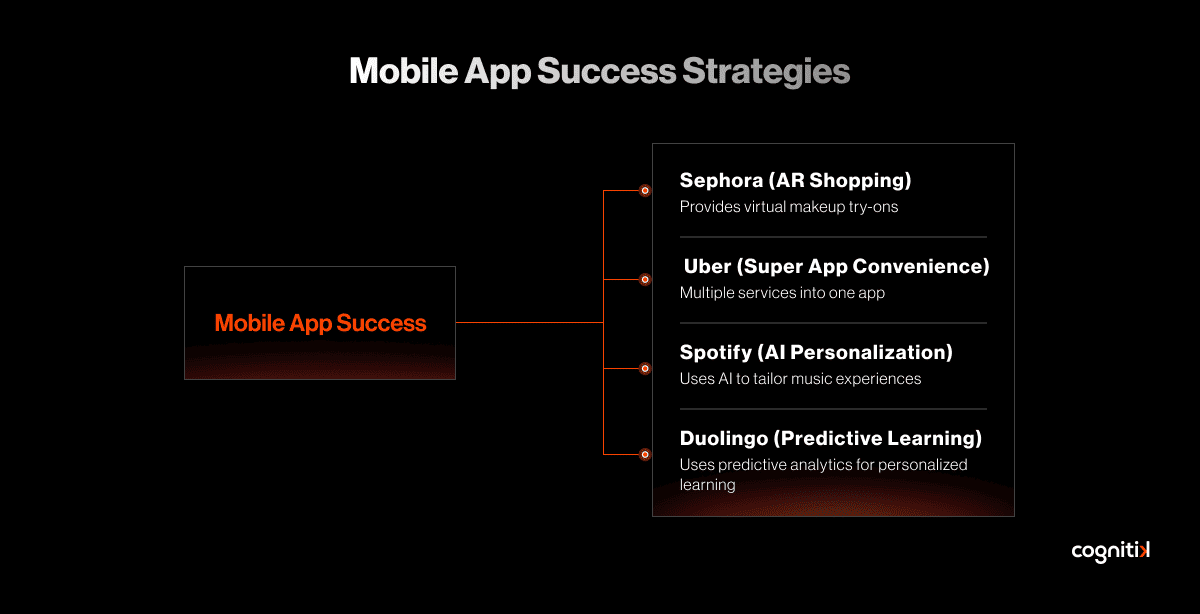Today, almost everything you need, connecting with friends, learning something new, or getting things done, is right at your fingertips. That’s what mobile apps do. They make life easier, whether it’s ordering food, booking a ride, managing tasks, or just taking a break after a long day. And often, we don’t even notice how much they influence our daily routines.
Similarly, for businesses, apps have become more than just tools; they’re a way to grow and stay relevant. They help brands reach people, build loyalty, and keep ahead of the competition. Startups use apps to try out ideas fast, while learners find practical skills that actually matter.
In this blog, we’ll look at the latest mobile app trends in simple, clear language with real examples, showing how they can help your business, project, or personal growth.
Trends That are Shaping Mobile Apps Today

Mobile apps are evolving faster than ever, becoming smarter, more personal, and tuned to your needs. They help you do things more easily, connect more meaningfully, and explore the world around you seamlessly. From adaptive experiences to innovative tools, today’s app trends are shaping how you work, play, and navigate daily life in ways that feel effortless.
1. AI-Powered Apps
When we talk about AI, it’s not just about the future anymore. AI is part of the apps you interact with every day, quietly learning what you like and shaping experiences to fit your preferences. It helps you discover new content, products, or skills without extra effort, making apps feel more personal and intuitive.
For example, when you open Netflix and see shows that feel like they were picked just for you, that’s AI working for you. It doesn’t just push popular titles; it studies what you’ve watched and recommends the ones you’re most likely to enjoy.
The same happens when Spotify builds a playlist that matches your mood or taste in music. And with Duolingo, lessons don’t stay the same for everyone; they adjust based on your progress. It makes learning easier and more natural for you. These examples reflect the power of AI to make everyday tasks feel seamless.
2. 5G-Powered Apps
We all know how 5G has transformed the way we connect, and you can feel the difference every time you use your favorite apps. With faster speeds and stronger connections, apps don’t just load quicker; they deliver smoother, richer experiences that keep up with your pace.
The best example of 5G-powered apps is when you are having a video call on Zoom, a 5G connection makes your conversations feel more natural without any lag, and the picture stays crystal clear. In cloud gaming, every move responds instantly, so you’re fully in the game without delays. Even AR and VR apps run seamlessly, bringing interactive experiences to life.
3. IoT & Connected Apps
You’ve probably noticed how apps aren’t limited to your phone anymore. These mobile apps can now connect and control the devices around you. That’s how IoT works, linking apps with devices so they can communicate with each other, making everyday life smoother and businesses more efficient by keeping everything connected.
Fitbit is a good example of an IoT-based app. The app displays your health metrics in real-time, helping you stay on track. With Alexa, you can control smart devices in your home with just your voice. And with Philips Hue, adjusting your lights through an app is as simple as a tap, creating comfort and control that feels effortless.
4. AR & VR in Apps
Have you ever thought that you could not just see things but truly experience them through an app? That’s what AR and VR make possible, turning everyday interactions into immersive, lifelike experiences. From shopping to gaming to socializing, these apps change how you connect with the world.
Several online stores, like IKEA with its IKEA Place app, help you experience how your sofa or table would look in your home before you buy it. Pokémon Go takes you outside, blending gaming with real-world exploration. And on Meta’s VR platforms, you can step into virtual spaces and share moments with others.
5. Mobile App Security
Every time you use an app, you’re sharing something personal. It could be your messages, payment details, or other sensitive information. That’s why security isn’t just a feature anymore; it’s the foundation of trust. Without it, even the smartest app loses its value.
In this case, WhatsApp is a great example, which protects your conversations with end-to-end encryption so no one else can read them. Google Pay adds another layer with multi-factor authentication, keeping your money safe when you make payments. Banking apps go even further, using advanced security protocols to guard your accounts. For you, it means confidence that your digital life stays private and protected.
6. Super Apps
It’s always frustrating when you have to switch between multiple apps just to get things done. One for messaging, another for payments, and yet another for food delivery. But super apps solve this by combining all these services in one place, making life smoother and simpler for you.
A perfect example is WeChat, which doesn’t just let you chat with friends—it also handles shopping, payments, and booking services. Grab is a popular app in Southeast Asia that combines transportation services, food delivery, and payments into a single platform. In India, Paytm lets you pay bills, shop online, and manage financial services all within one platform. With super apps, everything you need is just a tap away, saving you time and effort every day.
7. Predictive Analytics
Predictive analytics is like having an app that understands you so well, it seems to think ahead of your needs. By analyzing how you use apps and what you like, it can suggest what you might need or enjoy next, making your experience smoother and more effortless.
Amazon is an excellent example in this case. It doesn’t just show you popular items; it recommends products you might need next based on your browsing and buying habits. YouTube works the same way, suggesting videos that match your interests and viewing patterns. With predictive analytics, apps go beyond responding to you; they anticipate your preferences, helping you discover what matters most without extra effort.
How App Trends Can Boost Your Business, Startup, or Career/How Mobile App Trends Help Businesses, Startups, and Learners/The Importance of Following App Trends for Modern Experiences

If you’ve ever wondered why some apps feel effortless and modern while others feel outdated, the answer often lies in trends.
Here’s why keeping up with trends matters for businesses, startups, and learners, and how it helps you stay ahead:
- For businesses: As a business, it is essential for you to stay on top of the trends. And to keep your apps competitive, relevant, and engaging, you must adapt to what users are expecting today. There are several trends in the market, like AI personalization, 5G speed, and connected devices, that help you deliver experiences that feel modern, intuitive, and valuable to your audience.
- For startups: If you are a startup, following trends gives you a head start. It helps you innovate faster, make smarter decisions, and spot opportunities to disrupt the market before others do. Apps that leverage emerging technology often gain attention, attract early adopters, and build credibility in a crowded space.
- For learners: As a learner, it becomes even more important to understand and master the current trends to align with today’s most in-demand skills. Having knowledge of AI, AR/VR, IoT, and predictive analytics opens doors to future career opportunities. It helps you create, analyze, and manage apps that truly connect with people.
- For everyone: Following trends helps you know what’s next. No matter if you’re building, using, or learning about apps, staying updated puts you ahead.
And if you are looking for guidance on how to apply these trends to your app or project, Cognitik’s team can support you in creating smarter, modern, and user-focused mobile experiences.
Real World Mobile App Success Stories Driving Growth

When you are following trends, you can transform apps, engage users, and drive growth. When technology is used thoughtfully, it creates experiences people love and keeps them coming back. Here are some real-life examples to understand it better:
1. Spotify: Smarter Listening with AI
Spotify is one of the best examples of AI in action for music apps. It uses AI to personalize your music experience. Every playlist, from Discover Weekly to Daily Mix, is tailored to your listening habits. This makes discovering new songs effortless and keeps you engaged, turning casual listeners into loyal fans.
2. Sephora: AR for Smarter Shopping
Sephora is making online shopping easier with its Virtual Artist app that uses AR to let you try on makeup before buying. You can see how different shades of lipstick or eyeshadow look on you in real time. This interactive experience builds confidence, reduces guesswork, and makes shopping fun.
3. Uber: Super App Convenience
Uber, now evolving into a super app, combines rides, food delivery with Uber Eats, and other services in one platform. By combining multiple offerings in one app, it saves users time and keeps them engaged across different needs, creating convenience that encourages loyalty.
4. Duolingo: Predictive Learning Made Easy
Duolingo, one of the most popular language-learning apps, uses predictive analytics to adjust lessons based on your progress. The app anticipates what you’re ready to learn next, helping you stay motivated and improving retention. This proactive approach keeps learners coming back and growing their skills.
These examples show that embracing trends like AI, AR, predictive analytics, and super app strategies isn’t just about being modern. It creates better user experiences, builds engagement, and drives growth in real, measurable ways.
Conclusion
The world of mobile apps is evolving faster than ever, driven by intelligence, personalization, and seamless experiences that people now expect as standard. These trends are not just the optional add-ons; they are already shaping the way users learn, shop, connect, and grow every single day. By embracing them, your mobile apps can move from being simple tools to becoming meaningful parts of people’s lives.
And if you want to build an app or explore how these innovations can give your existing product a stronger edge, Cognitik has a team of professionals ready to guide you. They can craft apps that don’t just keep pace with change, but set the stage for smarter, more impactful digital experiences.
FAQs
What are the top mobile app development trends?
Key trends include AI-powered personalization, integration of AR/VR, 5G connectivity, foldable device optimization, and the rise of super apps. These innovations aim to enhance user experience and app performance.
What role do IoT apps play in connected living?
IoT apps link devices like smartwatches, home assistants, and appliances to create a connected ecosystem. They help users track health, control devices remotely, and automate daily tasks, enhancing convenience and efficiency.
How does AI impact mobile app development?
AI impacts mobile app development by allowing apps to learn from user behavior, automate repetitive tasks, and deliver personalized experiences. This makes apps smarter, more intuitive, and tailored to individual preferences, enhancing engagement and overall usability.
What are super apps, and why are they trending?
Super apps integrate multiple services, messaging, payments, shopping, and ride-hailing into a single platform. They simplify user experiences, retain engagement, and provide convenience, making them increasingly popular worldwide.
How are AR and VR changing mobile apps?
AR and VR bring digital content into real-world experiences, making apps interactive and immersive. From virtual try-ons to gaming and training simulations, these technologies increase engagement and create unique experiences for users.